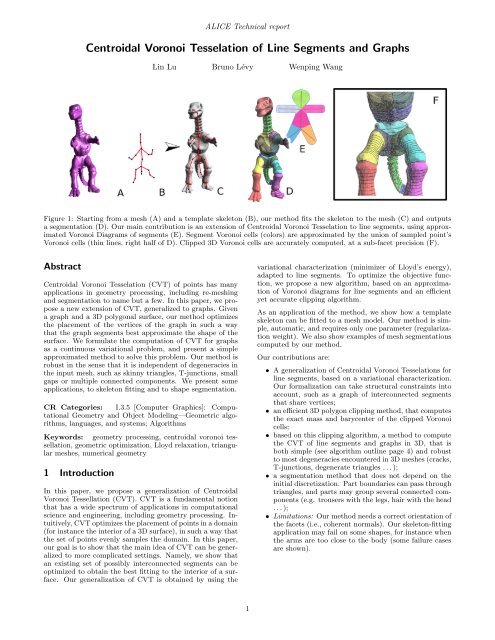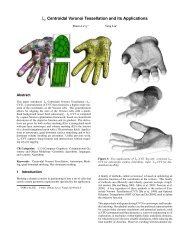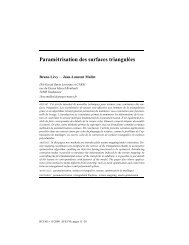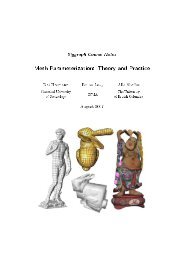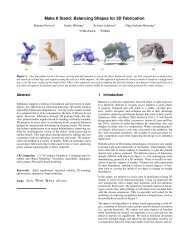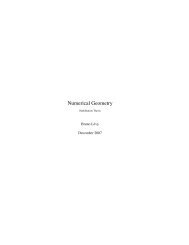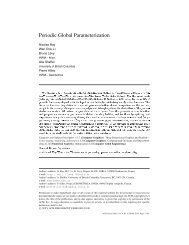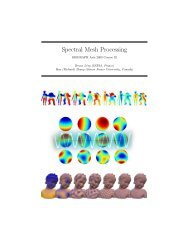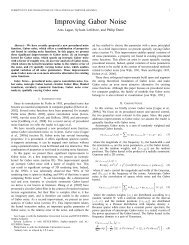Centroidal Voronoi Tesselation of Line Segments and Graphs - alice
Centroidal Voronoi Tesselation of Line Segments and Graphs - alice
Centroidal Voronoi Tesselation of Line Segments and Graphs - alice
Create successful ePaper yourself
Turn your PDF publications into a flip-book with our unique Google optimized e-Paper software.
ALICE Technical report<br />
<strong>Centroidal</strong> <strong>Voronoi</strong> <strong>Tesselation</strong> <strong>of</strong> <strong>Line</strong> <strong>Segments</strong> <strong>and</strong> <strong>Graphs</strong><br />
Lin Lu Bruno Lévy Wenping Wang<br />
Figure 1: Starting from a mesh (A) <strong>and</strong> a template skeleton (B), our method fits the skeleton to the mesh (C) <strong>and</strong> outputs<br />
a segmentation (D). Our main contribution is an extension <strong>of</strong> <strong>Centroidal</strong> <strong>Voronoi</strong> <strong>Tesselation</strong> to line segments, using approximated<br />
<strong>Voronoi</strong> Diagrams <strong>of</strong> segments (E). Segment <strong>Voronoi</strong> cells (colors) are approximated by the union <strong>of</strong> sampled point’s<br />
<strong>Voronoi</strong> cells (thin lines, right half <strong>of</strong> D). Clipped 3D <strong>Voronoi</strong> cells are accurately computed, at a sub-facet precision (F).<br />
Abstract<br />
<strong>Centroidal</strong> <strong>Voronoi</strong> <strong>Tesselation</strong> (CVT) <strong>of</strong> points has many<br />
applications in geometry processing, including re-meshing<br />
<strong>and</strong> segmentation to name but a few. In this paper, we propose<br />
a new extension <strong>of</strong> CVT, generalized to graphs. Given<br />
a graph <strong>and</strong> a 3D polygonal surface, our method optimizes<br />
the placement <strong>of</strong> the vertices <strong>of</strong> the graph in such a way<br />
that the graph segments best approximate the shape <strong>of</strong> the<br />
surface. We formulate the computation <strong>of</strong> CVT for graphs<br />
as a continuous variational problem, <strong>and</strong> present a simple<br />
approximated method to solve this problem. Our method is<br />
robust in the sense that it is independent <strong>of</strong> degeneracies in<br />
the input mesh, such as skinny triangles, T-junctions, small<br />
gaps or multiple connected components. We present some<br />
applications, to skeleton fitting <strong>and</strong> to shape segmentation.<br />
CR Categories: I.3.5 [Computer Graphics]: Computational<br />
Geometry <strong>and</strong> Object Modeling—Geometric algorithms,<br />
languages, <strong>and</strong> systems; Algorithms<br />
Keywords: geometry processing, centroidal voronoi tessellation,<br />
geometric optimization, Lloyd relaxation, triangular<br />
meshes, numerical geometry<br />
1 Introduction<br />
In this paper, we propose a generalization <strong>of</strong> <strong>Centroidal</strong><br />
<strong>Voronoi</strong> Tessellation (CVT). CVT is a fundamental notion<br />
that has a wide spectrum <strong>of</strong> applications in computational<br />
science <strong>and</strong> engineering, including geometry processing. Intuitively,<br />
CVT optimizes the placement <strong>of</strong> points in a domain<br />
(for instance the interior <strong>of</strong> a 3D surface), in such a way that<br />
the set <strong>of</strong> points evenly samples the domain. In this paper,<br />
our goal is to show that the main idea <strong>of</strong> CVT can be generalized<br />
to more complicated settings. Namely, we show that<br />
an existing set <strong>of</strong> possibly interconnected segments can be<br />
optimized to obtain the best fitting to the interior <strong>of</strong> a surface.<br />
Our generalization <strong>of</strong> CVT is obtained by using the<br />
variational characterization (minimizer <strong>of</strong> Lloyd’s energy),<br />
adapted to line segments. To optimize the objective function,<br />
we propose a new algorithm, based on an approximation<br />
<strong>of</strong> <strong>Voronoi</strong> diagrams for line segments <strong>and</strong> an efficient<br />
yet accurate clipping algorithm.<br />
As an application <strong>of</strong> the method, we show how a template<br />
skeleton can be fitted to a mesh model. Our method is simple,<br />
automatic, <strong>and</strong> requires only one parameter (regularization<br />
weight). We also show examples <strong>of</strong> mesh segmentations<br />
computed by our method.<br />
Our contributions are:<br />
• A generalization <strong>of</strong> <strong>Centroidal</strong> <strong>Voronoi</strong> <strong>Tesselation</strong>s for<br />
line segments, based on a variational characterization.<br />
Our formalization can take structural constraints into<br />
account, such as a graph <strong>of</strong> interconnected segments<br />
that share vertices;<br />
• an efficient 3D polygon clipping method, that computes<br />
the exact mass <strong>and</strong> barycenter <strong>of</strong> the clipped <strong>Voronoi</strong><br />
cells;<br />
• based on this clipping algorithm, a method to compute<br />
the CVT <strong>of</strong> line segments <strong>and</strong> graphs in 3D, that is<br />
both simple (see algorithm outline page 4) <strong>and</strong> robust<br />
to most degeneracies encountered in 3D meshes (cracks,<br />
T-junctions, degenerate triangles . . . );<br />
• a segmentation method that does not depend on the<br />
initial discretization. Part boundaries can pass through<br />
triangles, <strong>and</strong> parts may group several connected components<br />
(e.g. trousers with the legs, hair with the head<br />
. . . );<br />
• Limitations: Our method needs a correct orientation <strong>of</strong><br />
the facets (i.e., coherent normals). Our skeleton-fitting<br />
application may fail on some shapes, for instance when<br />
the arms are too close to the body (some failure cases<br />
are shown).<br />
1
ALICE Technical report<br />
Figure 2: Principle <strong>of</strong> our method: two examples <strong>of</strong> <strong>Centroidal</strong> <strong>Voronoi</strong> <strong>Tesselation</strong>s for connected line segments in 2D.<br />
2 Previous Work<br />
<strong>Centroidal</strong> <strong>Voronoi</strong> <strong>Tesselation</strong><br />
CVT for points A complete survey about CVT is beyond<br />
the scope <strong>of</strong> this paper. The reader is referred to the survey<br />
in [Du et al. 1999]. We will consider here the context <strong>of</strong><br />
Geometry Processing, where CVT was successfully applied<br />
to various problems. Alliez et al. developed methods for<br />
surface remeshing [2002], surface approximation [2004] <strong>and</strong><br />
volumetric meshing [2005]. Valette et al. [2004; 2008] developed<br />
discrete approximations <strong>of</strong> CVT on mesh surfaces<br />
<strong>and</strong> applications to surface remeshing. In all these works,<br />
the nice mathematical formulation <strong>of</strong> CVT resulted in elegant<br />
algorithms that are both simple <strong>and</strong> efficient. However,<br />
they use some approximations, that make them dependent<br />
on the quality <strong>of</strong> the initial mesh. For instance, applications<br />
<strong>of</strong> these methods to mesh segmentation are constrained to<br />
follow the initial edges, <strong>and</strong> applications to 3D meshing need<br />
to approximate the clipped <strong>Voronoi</strong> cells using quadrature<br />
samples.<br />
Recently, the computation <strong>of</strong> CVT was fully characterized<br />
as a smooth variational problem, <strong>and</strong> solved with a quasi-<br />
Newton method [Liu et al. 2008]. In this paper, we use the<br />
smooth variational approach, <strong>and</strong> replace the approximations<br />
used in previous works with an accurate computation<br />
<strong>of</strong> the clipped 3D <strong>Voronoi</strong> cells, thus making our algorithm<br />
independent <strong>of</strong> the initial discretization.<br />
CVT for line segments A first attempt to compute<br />
segment CVT was made in 2D, in the domain <strong>of</strong> Non-<br />
Photorealistic Rendering [Hiller et al. 2003]. The approach is<br />
based on a heuristic, that is difficult to generalize in 3D, <strong>and</strong><br />
that cannot be applied to graphs (more on this below). In<br />
contrast, we propose a variational characterization <strong>of</strong> CVT<br />
together with a general algorithm to solve the variational<br />
problem.<br />
Skeleton Extraction<br />
Numerous methods have been proposed to extract the skeleton<br />
<strong>of</strong> a 3D shape. We refer the reader to the survey [Cornea<br />
<strong>and</strong> Min 2007]. Based on the underlying representation, they<br />
can be classified into two main families :<br />
Discrete volumetric methods resample the interior <strong>of</strong><br />
the surface, using for instance voxel grids [Ju et al. 2007;<br />
Wang <strong>and</strong> Lee 2008]. Baran et al.[2007] construct a discretized<br />
geometric graph <strong>and</strong> then minimize a penalty function<br />
to penalize differences in the embedded skeleton from<br />
the given skeleton. The advantage <strong>of</strong> volumetric methods is<br />
that since they resample the object, they are insensitive to<br />
poorly shaped triangles in the initial mesh. However, they<br />
are limited by the discretization <strong>and</strong> may lack precision, especially<br />
when the mesh has thin features.<br />
Continuous surface methods work on a polygonal mesh<br />
directly. Last year, [Au et al. 2008] proposed a simple skeleton<br />
extraction method based on Laplacian smoothing <strong>and</strong><br />
mesh contraction. However, since it relies on a differential<br />
operator on the mesh, it fails to give good results for meshes<br />
with bad quality or with unwanted shape features like spikes,<br />
hair or fur. Methods based on Reeb graph [Aujay et al. 2007]<br />
encounter the same problem. More importantly, they cannot<br />
extract a continuous skeleton from a mesh with multiple connected<br />
components. Methods that extract the skeleton from<br />
a segmentation <strong>of</strong> the model [Katz <strong>and</strong> Tal 2003], [Schaefer<br />
<strong>and</strong> Yuksel 2007],[de Aguiar et al. 2008] suffer from the same<br />
limitation.<br />
In this paper, we propose a volumetric method that directly<br />
uses the initial representation <strong>of</strong> the surface. At each iteration,<br />
the interior <strong>of</strong> the surface is represented by a set <strong>of</strong><br />
tetrahedra. Therefore our approach shares the advantage <strong>of</strong><br />
volumetric methods (robustness) <strong>and</strong> the advantage <strong>of</strong> surfacic<br />
ones (accuracy).<br />
3 <strong>Centroidal</strong> <strong>Voronoi</strong> Tessellation for line<br />
segments <strong>and</strong> graphs<br />
We now present our approach to generalize <strong>Centroidal</strong><br />
<strong>Voronoi</strong> <strong>Tesselation</strong> (CVT) to line segments <strong>and</strong> graphs.<br />
Such a generalization <strong>of</strong> CVT to line segments is likely to<br />
have several applications, such as skeleton fitting <strong>and</strong> segmentation<br />
demonstrated here, <strong>and</strong> also vector field visualization<br />
or image stylization. The idea is illustrated in Figure 2.<br />
This section is illustrated with 2D examples, but note that<br />
the notions presented here are dimension independent. Our<br />
results in 3D are shown further in the paper. As shown in<br />
Figure 2, starting from an initial configuration <strong>of</strong> the skeleton,<br />
we minimize in each <strong>Voronoi</strong> cell (colors) the integral<br />
<strong>of</strong> the squared distance to the skeleton (generalized Lloyd<br />
energy). This naturally fits the edges <strong>of</strong> the skeleton into<br />
the protrusions <strong>of</strong> the mesh.<br />
We first recall the usual definition <strong>of</strong> CVT for points (Section<br />
3.1), then we extend the definition to line segments <strong>and</strong><br />
graphs (Section 3.2), <strong>and</strong> introduce the approximation that<br />
we are using (Section 3.3). Section 3.4 introduces the regularization<br />
term, <strong>and</strong> Section 4 our solution mechanism.<br />
3.1 CVT for points<br />
CVT has diverse applications in computational science <strong>and</strong><br />
engineering, including geometry processing [Du et al. 1999;<br />
Alliez et al. 2005] <strong>and</strong> has gained much attention in recent<br />
years. In this paper we extend the definition <strong>of</strong> CVT to<br />
make it applicable for sets <strong>of</strong> inter-connected line segments<br />
(or graphs). We first give the usual definition <strong>of</strong> <strong>Voronoi</strong><br />
Diagram <strong>and</strong> <strong>Centroidal</strong> <strong>Voronoi</strong> <strong>Tesselation</strong>.<br />
2
ALICE Technical report<br />
(a)<br />
(b)<br />
Figure 3: CVT for points in 2D.<br />
Figure 5: <strong>Voronoi</strong> diagram <strong>of</strong> two line segments.(a)Accurate<br />
VD; (b)approximated VD.<br />
Let X = (x i) n i=1 be an ordered set <strong>of</strong> n seeds in R N . The<br />
<strong>Voronoi</strong> region V or(x i) <strong>of</strong> x i is defined by :<br />
V or(x i) = {x ∈ R N<br />
| ‖x − x i‖ ≤ ‖x − x j‖, ∀j ≠ i}.<br />
The <strong>Voronoi</strong> regions <strong>of</strong> all the seeds form the <strong>Voronoi</strong> diagram<br />
(VD) <strong>of</strong> X. Let us now consider a compact region<br />
Ω ⊂ R N (for instance, the interior <strong>of</strong> the square around Figure<br />
3-left). The clipped <strong>Voronoi</strong> diagram is defined to be the<br />
set <strong>of</strong> clipped <strong>Voronoi</strong> cells {V or(x i) ∩ Ω}.<br />
A <strong>Voronoi</strong> Diagram is said to be a <strong>Centroidal</strong> <strong>Voronoi</strong> <strong>Tesselation</strong><br />
(CVT) if each seed x i coincides with the barycenter<br />
<strong>of</strong> its clipped <strong>Voronoi</strong> cell (geometric characterization).<br />
An example <strong>of</strong> CVT is shown in Figure 3-right. This definition<br />
leads to Lloyd’s relaxation [Lloyd 1982], that iteratively<br />
moves all the seeds to the barycenter <strong>of</strong> their <strong>Voronoi</strong> cells.<br />
Alternatively, CVT can be also characterized in a variational<br />
way [Du et al. 1999], as the minimizer <strong>of</strong> Lloyd’s energy F :<br />
F (X) =<br />
nX<br />
Z<br />
f(x i) ; f(x i) =<br />
i=1<br />
V or(x i )∩Ω<br />
‖x−x i‖ 2 dx (1)<br />
Using this latter variational formulation, a possible way <strong>of</strong><br />
computing a CVT from an arbitrary configuration consists<br />
in minimizing F [Liu et al. 2008]. Now we explain how this<br />
variational point <strong>of</strong> view leads to a more natural generalization<br />
to line segments as compared to the geometric characterization<br />
used in Lloyd’s relaxation.<br />
3.2 CVT for line segments <strong>and</strong> graphs<br />
Besides points, it is well known that general objects such as<br />
line segments can also be taken as the generators <strong>of</strong> <strong>Voronoi</strong><br />
diagrams (see Figure 4). For instance, Hiller et al. [2003]<br />
have used line segments <strong>Voronoi</strong> diagrams to generalize the<br />
notion <strong>of</strong> stippling used in Non-Photorealistic Rendering.<br />
Their method uses a discretization on a pixel grid, <strong>and</strong> a<br />
heuristic based on a variant <strong>of</strong> Lloyd’s relaxation to move the<br />
segments. They translate each segment to the centroid <strong>of</strong> its<br />
<strong>Voronoi</strong> cell, <strong>and</strong> then align it with the cell’s inertia tensor.<br />
In our case, it is unclear how to apply this method to a set <strong>of</strong><br />
segments that share vertices (i.e. a graph). Moreover, using<br />
a pixel grid is prohibitively costly in 3D.<br />
For these two reasons, we consider the variational characterization<br />
<strong>of</strong> CVT, that we generalize to line segments. Let E<br />
be the set <strong>of</strong> line segments with the end points in X. We<br />
define the CVT energy for segment [x i, x j] in Ω as:<br />
g([x i, x j]) =<br />
Z<br />
Vor([x i ,x j ]) T Ω<br />
d(z, [x i, x j]) 2 dz, (2)<br />
where Vor([x i, x j]) = {z ∈ R N | d(z, [x i, x j]) ≤ d(z, [x k , x l ]),<br />
∀k, l ∈ E} <strong>and</strong> d(z, [x i, x j]) denotes the Euclidean distance<br />
from a point to the segment.<br />
Particularly, when the same vertex is shared by several line<br />
segments, they define a graph. We denote this graph by<br />
G := (X, E).<br />
Definition 1 A CVT for a graph G = (X, E) is the minimizer<br />
X <strong>of</strong> the objective function G defined by :<br />
G(X) = X<br />
g([x i, x j]). (3)<br />
i,j∈E<br />
In practice, minimizing G is non-trivial, due to the following<br />
two difficulties :<br />
• Computing the VD <strong>of</strong> line segments is complicated,<br />
since the bisector <strong>of</strong> two segments are curves (resp. surfaces<br />
in 3D) <strong>of</strong> degree 2. Some readily available s<strong>of</strong>tware<br />
solve the 2D case (e.g., VRONI [Held 2001] <strong>and</strong><br />
CGAL), but the problem is still open in 3D ;<br />
• supposing the VD <strong>of</strong> line segments is known, integrating<br />
distances over cells bounded by quadrics is non-trivial.<br />
3.3 Approximated CVT for segments <strong>and</strong> graphs<br />
For these two reasons, we use an approximation. As shown<br />
in Figure 5, we replace the segment [x i, x j] with a set <strong>of</strong><br />
samples (p k ) :<br />
p k = λ k x i + (1 − λ k )x j , λ k = [0, 1].<br />
Then the <strong>Voronoi</strong> cell <strong>of</strong> the segment can be approximated<br />
by the union <strong>of</strong> all intermediary points’ <strong>Voronoi</strong> cells, <strong>and</strong><br />
its energy g can be approximated as follows :<br />
Vor([x i, x j]) ≃ [ k<br />
Vor(p k ) ; g([x i, x j]) ≃ X k<br />
f(p k )<br />
Figure 4: CVT for segments in an ellipse.<br />
where f denotes the point-based energy (Equation 1).<br />
This yields the following definition :<br />
3
ALICE Technical report<br />
(a) (b) (c)<br />
Figure 6: A chained graph with 5 vertices <strong>and</strong> 4<br />
edges.(a)Input; (b)minimizer <strong>of</strong> CVT energy; (c)with regularization<br />
energy γ = 0.01.<br />
(a)<br />
(b)<br />
Figure 7: (a)γ = 0, 0.01 from left to right; (b) γ = 0, 0.03, 0.1<br />
respectively from left to right.<br />
Definition 2 An Approximate CVT for a graph G = (X, E)<br />
is the minimizer X <strong>of</strong> the objective function G e defined by :<br />
eG(X) = X X<br />
f(p k ) = X X<br />
f(λ k x i + (1 − λ k )x j).<br />
i,j∈E<br />
k<br />
i,j∈E<br />
where f denotes the point-based energy (Equation 1).<br />
Since it is based on a st<strong>and</strong>ard <strong>Voronoi</strong> diagram <strong>and</strong> Lloyd<br />
energy, the so-defined approximated objective function e G is<br />
much simpler to optimize than the original G given in Equation<br />
3. Note that G <strong>and</strong> e G depend on the same variables X.<br />
The intermediary samples p k = λ k x i + (1 − λ k )x j are not<br />
variables, since they depend linearly on x i <strong>and</strong> x j.<br />
To avoid degenerate minimizers, we now introduce a stiffness<br />
regularization term, similarly to what is done in variational<br />
surface design.<br />
3.4 Regularization, stiffness<br />
The CVT energy tends to maximize the compactness <strong>of</strong> the<br />
dual <strong>Voronoi</strong> cells, which is desired in general. However,<br />
some particular configurations may lead to unwanted oscillations.<br />
For instance, the (undesired) configuration shown in<br />
Figure 6(b) has a lower energy than the one shown in Figure<br />
6(c). Intuitively, the long thin cells in (c) have points that<br />
are far away from the skeleton. To avoid the configuration<br />
in (b) <strong>and</strong> favor the one in (c), we add a regularization term<br />
R(X) to the energy functional, defined as the squared graph<br />
Laplacian, that corresponds to the stiffness <strong>of</strong> the joints :<br />
R(X) =<br />
X<br />
x i ,v(x i )>1<br />
k<br />
‖x i − 1<br />
v(x i)<br />
X<br />
x j ∈N(x i )<br />
(4)<br />
x j‖ 2 , (5)<br />
where v(x i) denotes the valence, N(x i) the neighbors <strong>of</strong> x i.<br />
We can now define the objective function F minimized by<br />
our approach :<br />
F(X) = e G(X) + γ|Ω|R(X). (6)<br />
where e G(X) is the approximated Lloyd energy <strong>of</strong> the segments<br />
(Equation 4) <strong>and</strong> R(X) is the regularization term<br />
(Equation 5). γ ∈ R + denotes the influence <strong>of</strong> the regularization<br />
term. We used γ = 0.01 in all our experiments.<br />
Note that the regularization term R is multiplied by the<br />
volume <strong>of</strong> the object |Ω| so that e G <strong>and</strong> R have compatible<br />
dimensions.<br />
Figure 7 shows the influence <strong>of</strong> the parameter γ. For valence<br />
2 nodes, a high value <strong>of</strong> γ tends to straighten the joints.<br />
For branching nodes, a high value <strong>of</strong> γ tends to homogenize<br />
the segment angles <strong>and</strong> lengths. In our experiments,<br />
good results were obtained with γ = 0.02. It is also possible<br />
to assign a different stiffness γ i to each joint, to improve<br />
joint placement, but since this introduces too many parameters,<br />
we will show later a simpler method to automatically<br />
optimize joint placements, without needing any additional<br />
parameter.<br />
4 Solution mechanism<br />
To minimize the objective function F, we use an efficient<br />
quasi-Newton solver. A recent work on the CVT energy<br />
showed its C 2 smoothness [Liu et al. 2008] (except for some<br />
seldom encountered degenerate configurations where it is<br />
C 1 ). In our objective function F, the term ˜G composes<br />
linear interpolation with the Lloyd energy, <strong>and</strong> the regularization<br />
term R is a quadratic form. Therefore, F is also<br />
<strong>of</strong> class C 2 , which allows us to use second-order optimization<br />
methods. As such, Newton’s algorithm for minimizing<br />
functions operates as follows :<br />
(1) while ‖∇F(X)‖ > ɛ<br />
(2) solve for d in ∇ 2 F(X)d = −∇F(X)<br />
(3) find a step length α such that<br />
F(X + αd) sufficiently decreases<br />
(4) X ← X + αd<br />
(5) end while<br />
where ∇F(X) <strong>and</strong> ∇ 2 F(X) denote the gradient <strong>of</strong> F <strong>and</strong> its<br />
Hessian respectively. Computing the Hessian (second-order<br />
derivatives) can be time consuming. For this reason, we use<br />
L-BFGS [Liu <strong>and</strong> Nocedal 1989], a quasi-Newton method<br />
that only needs the gradient (first-order derivatives). The<br />
L-BFGS algorithm has a similar structure, with a main loop<br />
that updates X based on evaluations <strong>of</strong> F <strong>and</strong> ∇F. The<br />
difference is that in the linear system <strong>of</strong> line (2), the Hessian<br />
is replaced with a simpler matrix, obtained by accumulating<br />
successive evaluations <strong>of</strong> the gradient (see [Liu <strong>and</strong> Nocedal<br />
1989] <strong>and</strong> [Liu et al. 2008] for more details).<br />
In practice, one can use one <strong>of</strong> the readily available implementations<br />
<strong>of</strong> L-BFGS (e.g. TAO/Petsc).<br />
Thus, to minimize our function F with L-BFGS, what we<br />
need now is to be able to compute F(X) <strong>and</strong> ∇F(X) for<br />
a series <strong>of</strong> X iterates, as in the following outline, detailed<br />
below (next three subsections).<br />
4
ALICE Technical report<br />
Figure 8: Illustration <strong>of</strong> the sampling on the segments.<br />
Algorithm outline - CVT for line segments <strong>and</strong> graphs<br />
For each Newton iterate X<br />
1. For each segment [x i, x j], generate the samples p k ;<br />
2. For each p k , compute the clipped <strong>Voronoi</strong> cell <strong>of</strong> p k ,<br />
i.e. V or(p k ) ∩ Ω where Ω denotes the interior <strong>of</strong> the<br />
surface ;<br />
3. Add the contribution <strong>of</strong> each p k to F <strong>and</strong> ∇F.<br />
4.1 Generate the samples p k<br />
We choose a sampling interval h. In our experiments,<br />
1/100 th <strong>of</strong> the bounding box’s diagonal gives sufficient precision.<br />
We then insert a sample every h along the segments.<br />
Terminal vertices (<strong>of</strong> valence 1) are inserted as well.<br />
Vertices x i <strong>of</strong> valence greater than 1 are skipped, in order to<br />
obtain a good approximation <strong>of</strong> the bisectors near branching<br />
points (see Figure 8).<br />
4.2 Compute the clipped <strong>Voronoi</strong> cells<br />
We now compute the Delaunay triangulation <strong>of</strong> the samples<br />
p k (one may use CGAL for instance), <strong>and</strong> then the<br />
<strong>Voronoi</strong> diagram is obtained as the dual <strong>of</strong> the Delaunay<br />
triangulation. Now we need to compute the intersections<br />
between each <strong>Voronoi</strong> cell V or(p k ) <strong>and</strong> the domain Ω, defined<br />
as the interior <strong>of</strong> a triangulated surface. Since <strong>Voronoi</strong><br />
cells are convex (<strong>and</strong> not necessarily the surface), it is easier<br />
(though equivalent) to consider that we clip the surface by<br />
the <strong>Voronoi</strong> cell. To do so, we use the classical re-entrant<br />
clipping algorithm [Sutherl<strong>and</strong> <strong>and</strong> Hodgman 1974], recalled<br />
in Figure 9-A, that considers a convex window as the intersection<br />
<strong>of</strong> half-spaces applied one-by-one to the clipped<br />
object. In our 3D case, when clipping the triangulated surface<br />
with a half-space, each triangle can be considered independently.<br />
We show an example in Figure 9-B, where two<br />
bisectors generate Homer’s “trousers”. Since it processes<br />
the triangles one by one, the algorithm is extremely simple<br />
to implement, <strong>and</strong> does not need any combinatorial data<br />
structure. Moreover, it can be applied to a “triangle soup”,<br />
provided that the polygons have correct orientations (i.e.,<br />
coherent normals).<br />
However, it is important to mention that the surface needs<br />
to be closed after each half-space clipping operation. This<br />
is done by connecting each intersection segment (thick red<br />
in Figure 9-C) with the first intersection point, thus forming<br />
a triangle fan. Note that when the intersection line is<br />
non-convex, this may generate geometrically incorrect configurations,<br />
such as the sheet <strong>of</strong> triangles between the legs<br />
Figure 9: Sutherl<strong>and</strong>-Hogdman re-entrant clipping.<br />
in Figure 9-D. However, this configuration is correct from a<br />
computational point <strong>of</strong> view, if we keep the orientation <strong>of</strong><br />
the triangles, as explained in Figure 9-E. Suppose we want<br />
to compute the area <strong>of</strong> the “bean” shape, by summing triangles<br />
connected to the red vertex. With the orientation <strong>of</strong> the<br />
triangles, the extraneous area appears twice, with a positive<br />
<strong>and</strong> negative orientation that cancel-out. After the clipping<br />
operation, the clipped <strong>Voronoi</strong> cell <strong>of</strong> the point p k is represented<br />
by its boundary, as a list <strong>of</strong> triangles (q i, q j, q k ).<br />
The interior <strong>of</strong> the <strong>Voronoi</strong> cell is obtained as a set <strong>of</strong> oriented<br />
tetrahedra (p k , q i, q j, q k ), created by connecting p k to<br />
each triangle. Note also that p k may be outside its clipped<br />
<strong>Voronoi</strong> cell, but again, with the orientation <strong>of</strong> the tetrahedra,<br />
this still gives the correct result for Lloyd’s energy,<br />
barycenter <strong>and</strong> mass computed in the next section.<br />
4.3 Add the contributions to F <strong>and</strong> ∇F<br />
We first consider the approximated segment Lloyd energy<br />
eG. The CVT energy associated with a tetrahedron T =<br />
(p k , q 1, q 2, q 3) is given by<br />
|T |<br />
10 (U2 1 + U 2 2 + U 2 3 + U 1.U 2 + U 2.U 3 + U 3.U 1),<br />
where U i = q i − p k <strong>and</strong> |T | denotes the oriented volume <strong>of</strong><br />
T . To compute the gradients, we first recall the gradient <strong>of</strong><br />
the point-based Lloyd energy [Du et al. 1999], given by :<br />
∂F<br />
∂p k<br />
= 2m k (p k − c k )<br />
where:<br />
m k =<br />
R<br />
V or(p k )∩Ω<br />
dx ; c k = 1<br />
R<br />
m k<br />
V or(p k )∩Ω<br />
xdx<br />
By applying the chain rule to the expression <strong>of</strong> the intermediary<br />
points p k = λ k x i + (1 − λ k )x j, we obtain the gradient<br />
(7)<br />
5
ALICE Technical report<br />
Figure 11: Influence <strong>of</strong> the initialization.<br />
Figure 10: Fitting <strong>and</strong> segmentation before (top) <strong>and</strong> after<br />
joint optimization (bottom). Notice the rightmost knee.<br />
<strong>of</strong> e G for the edge [x i, x j] :<br />
∂ e G<br />
∂x i<br />
= X k<br />
= X k<br />
∂ e G<br />
∂x j<br />
= X k<br />
∂f(p k )<br />
∂x i<br />
∂f(p k ) ∂p k<br />
= 2 X ∂p k ∂x i<br />
k<br />
∂f(p k )<br />
∂x j<br />
= 2 X k<br />
m k (p k − c k )λ k ;<br />
m k (p k − c k )(1 − λ k ),<br />
where m k <strong>and</strong> c k denote the mass <strong>and</strong> the centroid <strong>of</strong><br />
V or(p k ) ∩ Ω respectively (see Equation 7). Note that m k<br />
<strong>and</strong> c k can be easily computed from the clipped <strong>Voronoi</strong> cell,<br />
represented by a union <strong>of</strong> oriented tetrahedra (see section 4).<br />
The gradient <strong>of</strong> e G with respect to the graph vertex x i gathers<br />
the contributions <strong>of</strong> all the gradients <strong>of</strong> the sampling points<br />
p k in the segments incident to x i.<br />
The contribution <strong>of</strong> the regularization term to the gradient<br />
∇R is given by :<br />
0<br />
∂R<br />
= 2|Ω|γ i<br />
@x i − 1<br />
∂x i v(x i)<br />
4.4 Optimize joint placement<br />
X<br />
x j ∈N(x i )<br />
x j<br />
1<br />
A .<br />
The objective function F only takes geometry into account,<br />
<strong>and</strong> does not necessarily places the joints where the user expects<br />
them. For instance, for a straight arm, the joint will<br />
be located at the middle, which does not necessarily corresponds<br />
to the elbow. However, from the information computed<br />
by our algorithm, it is easy to optimize the location <strong>of</strong><br />
the joints. Our algorithm computes all the intersections between<br />
the <strong>Voronoi</strong> cells <strong>and</strong> the mesh, shown as black lines<br />
in Figure 10. Each black line is associated with a sample<br />
<strong>of</strong> the skeleton. The elbows correspond to constrictions, i.e.<br />
black lines <strong>of</strong> minimal length. Therefore, for each joint, we<br />
determine the sample in the neighborhood <strong>of</strong> the joint that<br />
has an intersection curve <strong>of</strong> minimal length, <strong>and</strong> move the<br />
joint to the location <strong>of</strong> this sample. For each joint x i, we<br />
test the samples in all the bones connected to x i, in the half<br />
<strong>of</strong> the bone that contains x i.<br />
5 Results <strong>and</strong> conclusion<br />
We have experimented with our method using several<br />
datasets. For a typical mesh, our method converged in 5<br />
Newton iterations, which takes 2 minutes on a 2.5 GHz machine.<br />
As demonstrated in Figure 11, our method is reasonably<br />
independent <strong>of</strong> the initial position (A,B), but may fail for<br />
more extreme initially mismatched configurations (C). In<br />
subsequent tests, initialization is provided by aligning the<br />
bounding box <strong>of</strong> the skeleton, as done in [Baran <strong>and</strong> Popović<br />
2007]. Our method is robust to mesh degeneracies (Figure<br />
12), such as T-Junctions, <strong>and</strong> small gaps (red lines), thanks<br />
to the accurate computation <strong>of</strong> clipped <strong>Voronoi</strong> cells (thick<br />
black lines) <strong>and</strong> the triangle-by-triangle (or tet-by-tet) integration.<br />
Figure 13 shows that noisy meshes with skinny<br />
triangles can be processed without any numerical instability<br />
(data acquired by the Visual Hull technique). To our<br />
knowledge, this is the first method that achieves this degree<br />
<strong>of</strong> robustness.<br />
Figure 14 shows the influence <strong>of</strong> the edge sampling interval<br />
h, used to approximate the segment <strong>Voronoi</strong> cells. As can be<br />
seen, a coarse sampling is sufficient to obtain a result similar<br />
to the one obtained with a finer sampling. However, we use<br />
h = 1/100 th <strong>of</strong> the bounding box diagonal (left), to have<br />
enough samples for the joint placement optimization phase<br />
(Section 4.4).<br />
We show in Figure 15 some examples from the SHREK<br />
database. More examples are shown in Figure 16. Except<br />
for a small number <strong>of</strong> failure cases (red crosses), satisfying<br />
results were obtained. Our method was successfully applied<br />
to meshes with degeneracies (multiple components, holes,<br />
T-junctions) that cannot be processed by previous work.<br />
In addition, a segmentation is obtained, that can be used<br />
for matching features between meshes <strong>and</strong> morphing. Our<br />
method failed in some cases. One example <strong>of</strong> failure is shown<br />
in Figure 15 (red cross), where the arms are close to the body.<br />
Figure 17 compares our method with the method using mesh<br />
contraction [Au et al. 2008]. The Monkey’s hair appear as<br />
singularities in Laplacian computation (A). Our volumetric<br />
method is not affected by these singularities (B). Surfacic<br />
methods cannot generate a connected skeleton for a mesh<br />
with multiple components (C), whereas our volumetric approach<br />
does not “see” the boundaries between them (D).<br />
6
ALICE Technical report<br />
Figure 15: Humen from the SHREK database.<br />
Figure 13: Robustness to mesh degeneracies (flat triangles).<br />
Figure 12: Robustness to mesh degeneracies (small holes).<br />
Figure 14: Influence <strong>of</strong> the skeleton sampling. With a coarse<br />
sampling <strong>of</strong> the skeleton (right) one obtains a result similar<br />
to the one obtained with a finer sampling (left).<br />
7
ALICE Technical report<br />
Figure 16: More results <strong>of</strong> our method.<br />
Conclusion We have presented in this paper a new method<br />
for variational skeleton fitting. Its main advantages are :<br />
• Simplicity: the problem <strong>of</strong> skeleton fitting is expressed<br />
in variational form (Equation 6), requiring no more<br />
than minimizing an objective function. The gradients<br />
are easily computed by our <strong>Voronoi</strong> clipping;<br />
• Robustness: the triangle-by-triangle integration (tetby-tet)<br />
does not need a connected mesh, <strong>and</strong> does not<br />
estimate differential quantities, therefore our method<br />
works with degenerate meshes.<br />
This paper showed results for skeleton fitting <strong>and</strong> shape segmentation.<br />
We think that other applications are possible,<br />
such as shape morphing, shape retrieval <strong>and</strong> markerless motion<br />
capture by fitting skeletons to mesh sequences acquired<br />
by computer vision. We showed that generalizing the <strong>Centroidal</strong><br />
<strong>Voronoi</strong> <strong>Tesselation</strong> framework to primitives that are<br />
more general than points is possible. Beyond the graph <strong>of</strong><br />
segments considered here, in future work we will consider<br />
CVT-based shape optimization by defining CVT with other<br />
types <strong>of</strong> primitives (i.e. cylinders, plates . . . ).<br />
Acknowledgments<br />
References<br />
will be given in the final version.<br />
Alliez, P., Meyer, M., <strong>and</strong> Desbrun, M. 2002. Interactive Geometry<br />
Remeshing. ACM TOG (Proc. SIGGRAPH) 21(3), 347–354.<br />
Alliez, P., Cohen-Steiner, D., Yvinec, M., <strong>and</strong> Desbrun, M. 2005.<br />
Variational tetrahedral meshing. ACM TOG (Proc. SIGGRAPH).<br />
Au, O. K.-C., Tai, C.-L., Chu, H.-K., Cohen-Or, D., <strong>and</strong> Lee, T.-Y.<br />
2008. Skeleton extraction by mesh contraction. ACM TOG (Proc.<br />
SIGGRAPH .<br />
Aujay, G., Hétroy, F., Lazarus, F., <strong>and</strong> Depraz, C. 2007. Harmonic<br />
skeleton for realistic character animation. In Proc. SCA.<br />
Baran, I., <strong>and</strong> Popović, J. 2007. Automatic rigging <strong>and</strong> animation <strong>of</strong><br />
3d characters. ACM TOG (Proc. SIGGRAPH .<br />
Cohen-Steiner, D., Alliez, P., <strong>and</strong> Desbrun, M. 2004. Variational<br />
shape approximation. ACM TOG (Proc. SIGGRAPH).<br />
Cornea, N. D., <strong>and</strong> Min, P. 2007. Curve-skeleton properties, applications,<br />
<strong>and</strong> algorithms. IEEE TVCG 13, 3.<br />
Figure 17: Comparison between Au et al.’s mesh-contraction<br />
(left) <strong>and</strong> our method (right).<br />
de Aguiar, E., Theobalt, C., Thrun, S., <strong>and</strong> Seidel, H.-P. 2008. Automatic<br />
Conversion <strong>of</strong> Mesh Animations into Skeleton-based Animations.<br />
Computer Graphics Forum (Proc. Eurographics).<br />
Du, Q., Faber, V., <strong>and</strong> Gunzburger, M. 1999. <strong>Centroidal</strong> <strong>Voronoi</strong><br />
tessellations: applications <strong>and</strong> algorithms. SIAM Review.<br />
Held, M. 2001. VRONI: An engineering approach to the reliable<br />
<strong>and</strong> efficient computation <strong>of</strong> voronoi diagrams <strong>of</strong> points <strong>and</strong> line<br />
segments. Computational Geometry: Theory <strong>and</strong> Applications.<br />
Hiller, S., Hellwig, H., <strong>and</strong> Deussen, O. 2003. Beyond stipplingmethods<br />
for distributing objects on the plane. Computer Graphics<br />
Forum.<br />
Ju, T., Baker, M. L., <strong>and</strong> Chiu, W. 2007. Computing a family <strong>of</strong><br />
skeletons <strong>of</strong> volumetric models for shape description. CAD.<br />
Katz, S., <strong>and</strong> Tal, A. 2003. Hierarchical mesh decomposition using<br />
fuzzy clustering <strong>and</strong> cuts. ACM TOG.<br />
Liu, D. C., <strong>and</strong> Nocedal, J. 1989. On the limited memory BFGS<br />
method for large scale optimization. Mathematical Programming:<br />
Series A <strong>and</strong> B 45, 3, 503–528.<br />
Liu, Y., Wang, W., Lévy, B., Sun, F., Yan, D. M., Lu, L., <strong>and</strong> Yang, C.<br />
2008. On centroidal voronoi tessellation - energy smoothness <strong>and</strong><br />
fast compu tation. Tech. rep., Hong-Kong University <strong>and</strong> INRIA -<br />
ALICE Project Team. Accepted pending revisions.<br />
Lloyd, S. P. 1982. Least squares quantization in PCM. IEEE Transactions<br />
on Information Theory 28, 2, 129–137.<br />
Schaefer, S., <strong>and</strong> Yuksel, C. 2007. Example-based skeleton extraction.<br />
In Proc. SGP.<br />
Sutherl<strong>and</strong>, I. E., <strong>and</strong> Hodgman, G. W. 1974. Reentrant polygon<br />
clipping. Comm. ACM 17, 1, 32–42.<br />
Valette, S., <strong>and</strong> Chassery, J.-M. 2004. Approximated centroidal<br />
<strong>Voronoi</strong> diagrams for uniform polygonal mesh coarsening. Computer<br />
Graphics Forum (Proc. Eurographics).<br />
Valette, S., Chassery, J.-M., <strong>and</strong> Prost, R. 2008. Generic remeshing<br />
<strong>of</strong> 3D triangular meshes with metric-dependent discrete <strong>Voronoi</strong><br />
diagrams. IEEE TVCG.<br />
Wang, Y.-S., <strong>and</strong> Lee, T.-Y. 2008. Curve-skeleton extraction using<br />
iterative least squares optimization. IEEE TVCG.<br />
8


